A Multimodal Research Approach to Assessing the Karst Structural Conditions of the Ceiling of a Cave with Palaeolithic Cave Art Paintings: Polychrome Hall at Altamira Cave (Spain)
Abstract
:1. Introduction
2. Materials and Methods
2.1. General Workflow
2.2. Ground-Penetrating Radar
2.2.1. Field Data Acquisition: Polychrome Hall ceiling
2.2.2. Data Processing
Velocity Estimation
Processing Flow
- As in our case, when the RADAN processing software is used, the initial component of the DC signal—also known as DC shift—as well as the low-frequency trend, is automatically removed. The DC shift is usually the first processing step/filter applied to the data after acquisition [66].
- Zero-time correction (zero-time adjustment) is applied to remove the delay time in the first reflection to correct for the effect of the distance between the transmitting (T) and the receiving antennas (R) and possible variations in the arrival time of the direct waves.In the second phase, 2D processing was applied to the profiles based on the following points:
- Background filtering was applied to remove the average values on all traces on the horizontal axis (horizontal bands) based on the antennas used. The average of all traces was calculated by averaging all traces in the profile and subtracting them from each trace starting at time zero.
- Various bandpass filters were applied depending on the centre frequencies of the antennas used to remove high and low-frequency noise in the vertical and horizontal directions.
- Linear amplitude gains were applied to compensate for amplitude reduction due to the filters run. This allowed for the highlighting or enhancement of certain amplitudes.
- Kirchhoff migration was applied to the profiles using the calculated average velocity (0.109 m/ns) to move the reflectors to their true subsurface positions.
- Time-to-depth conversion was performed for the rock mass based on a calculated average velocity of 0.109 m/ns.
3. Results
3.1. Polychrome Overlying Layer Hydrology
- Drainage Basins: Drainage basins, also known as watersheds, are areas of land from which all surface water flows into a common outlet such as a river. These basins are delineated by the topography of the land, with higher elevations forming the basin boundaries.
- Catchment Basins: Catchment basins follow the same concept as drainage basins. They are the geographical areas that contribute runoff water to a single point, usually a river or stream.
- Flow Direction: Flow direction in hydrology and GIS refers to the direction in which water flows across the terrain. It is a crucial part of modelling the movement of water in a digital environment.
- Watercourses: Watercourses are natural or man-made channels through which water flows.
- Flow Accumulation Zones: Flow accumulation zones are areas within a watershed where water from surrounding areas converge. These areas are typically identified by analysing the terrain and the direction of the flow of water.
- Flow Distance: Flow distance is the distance water travels along the terrain to reach a specific point downstream.
- Sinks: In hydrology, sinks are depressions or low points in the terrain where water can accumulate. These are especially interesting for our case study because they represent the points where all the captured water is introduced into the limestone package.
- Strahler Method for Watercourse Classification [77,78]: This is a technique used to classify the hierarchical order of watercourses within a watershed. In this method, the smallest headwater streams are designated as first-order streams. When two first-order streams converge, they form a second-order stream, and so on. This classification helps to explain the branching structure of a watershed’s drainage network.
3.2. Internal Stratigraphy
- Polychrome layer: this limestone layer is about 60–70 cm thick and tapers towards the south. The base exhibits hydroplastic deformation, which is significant as the Palaeolithic paintings are at its base, taking advantage of the hydroplastic deformations’ shapes.
- Dolomitic layer: this dolostone layer (10–25 cm thick) displays varying degrees of dolomitization. A thin loamy-clay intercalation separates it from the Polychrome level.
- Fissured layer: a limestone layer, about 1.1 m thick, that is visible throughout the cave. It is recognized by its unique alteration pattern characterized by vertical dissolution morphologies associated with joints.
- Orange layer: this layer consists of thin-bedded limestone (10–20 cm each) with a total thickness between 0.7 and 1 m.
- Upper layer: this layer alternates between calcarenite and limestone, with thin marl interbeds. It has a total thickness of about 2 m.
3.3. Layer Overlying the Polychrome Hall
4. Discussion
5. Conclusions
Author Contributions
Funding
Institutional Review Board Statement
Informed Consent Statement
Data Availability Statement
Acknowledgments
Conflicts of Interest
References
- Pike, A.W.G.; Hoffmann, D.L.; García-Díez, M.; Pettitt, P.B.; Alcolea, J.; De Balbín, R.; González-Sainz, C.; de las Heras, C.; Lasheras, J.A.; Montes, R.; et al. U-Series Dating of Paleolithic Art in 11 Caves in Spain. Science 2012, 336, 1409–14013. [Google Scholar] [CrossRef]
- Guinea, G. Altamira y Otras Cuevas de Cantabria; Sílex Ediciones: Madrid, Spain, 1979; ISBN 84-85041-34-8. [Google Scholar]
- León, J. Sobre la protección de las pinturas de la Cueva de Altamira. Cuad. De Espeleol. 1971, 5–6, 161–168. [Google Scholar]
- Villar, E. Proyecto Científico Técnico Encaminado a la Conservación de las Pinturas de Altamira; Centro de Investigación y Museo de Altamira. Monografías 5; Ministerio de Cultura: Madrid, Spain, 1979. [Google Scholar]
- Cabrera Garrido, J.M. Conservación de la Cueva de Altamira: Sugerencias para un programa de trabajo. In Altamira Symposium; Ministerio de Cultura: Madrid, Spain, 1981; pp. 621–641. [Google Scholar]
- Ministerio de Cultura y Deporte, Universidad de Cantabria; CSIC, Universidad del País Vasco; de Guichen, G. Programa de Investigación para la Conservación Preventiva y Régimen de Acceso de la Cueva de Altamira (2012–2014); Ministerio de Cultura y Deporte: Madrid, Spain, 2014; Volume II. [Google Scholar]
- Ministerio de Cultura y Deporte, Universidad de Cantabria; CSIC, Universidad del País Vasco; de Guichen, G. Programa de Investigación para la Conservación Preventiva y Régimen de Acceso de la Cueva de Altamira (2012–2014); Ministerio de Cultura y Deporte: Madrid, Spain, 2014; Volume IV. [Google Scholar]
- Sánchez-Moral, S. Estudio integral del estado de conservación de la Cueva de Altamira y su arte paleolítico (2007–2009). Perspectivas futuras de conservación. In Monografías del Museo Nacional y Centro de Investigación de Altamira, No. 24; Ministerio de Educación, Cultura y Deporte: Madrid, Spain, 2014. [Google Scholar]
- Hoyos, M. Procesos de alteración de soporte y pintura en diferentes cuevas con arte rupestre del norte de España: Santimamiñe, Arenaza, Altamira y Llonín. In La Protección y Conservación del Arte Rupestre Paleolítico; Fortea, J., Ed.; Consejería de Educación, Cultura, Deportes y Juventud del Principado de Asturias: Oviedo, Spain, 1992; pp. 51–74. [Google Scholar]
- Hoyos, M.; Bustillo, A.; García, A.; Martin, C.; Ortiz, R.; y Suazo, C. Características Geológico-Kársticas de la Cueva de Altamira (Santillana del Mar, Santander); Informe Ministerio de Cultura: Madrid, Spain, 1981; p. 81. [Google Scholar]
- Sánchez, M.A.; Foyo, A.; Tomillo, C.; Iriarte, E. Geological risk assessment of the area surrounding Altamira Cave: A proposed Natural Risk Index and Safety Factor for protection of prehistoric caves. Eng. Geol. 2007, 94, 180–200. [Google Scholar] [CrossRef]
- Elez, J.; Cuezva, S.; Fernández-Cortes, A.; García-Anton, E.; Benavente, D.; Cañaveras, J.C.; Sánchez-Moral, S. A GIS-based methodology to qualitatively define Adjacent Protected Area in shallow karst cavity: I.e. case of Altamira cave. J. Environ. Manag. 2013, 118, 122–134. [Google Scholar] [CrossRef]
- Valle, F.J.; Moya, J.S.; Cendrero, A. Estudio de la roca soporte de las pinturas rupestres de la cueva de Altamira. Zephyrus 1978, 28–29, 5–15. [Google Scholar]
- Cendrero, A. Influencia de la composición de la roca soporte en el deterioro de las pinturas de Altamira. In Altamira Symposium; Ministerio de Cultura: Madrid, Spain, 1981; pp. 579–580. [Google Scholar]
- Villar, E. Estudio Físico-Químicos Sobre la Cueva de Altamira; Centro de Investigación y Museo de Altamira. Monografías 9; Ministerio de Cultura: Madrid, Spain, 1983. [Google Scholar]
- Fernández, P.L.; Gutiérrez, I.; Quindós, L.S.; Soto, J.; Villar, E. Natural ventilation of the paintings room in the Altamira cave. Nature 1986, 321, 586–588. [Google Scholar] [CrossRef]
- Sánchez-Moral, S.; Cuezva, S.; Fernández-Cortés, A.; Benavente, D.; Cañaveras, J.C. Effect of ventilation on karst system equilibrium (Altamira Cave, N Spain): An appraisal of karst contribution to the global carbon cycle balance. In Advances in Research in Karst Media; Andreo, B., Carrasco, F., Duran, J.J., LaMoreaux, J.W., Eds.; Springer: Berlin, Germany, 2010. [Google Scholar]
- Bayarri, V. Algoritmos de Análisis de Imágenes Multiespectrales e Hiperespectrales para la Documentación e Interpretación del Arte Rupestre. Ph.D. Thesis, Universidad Nacional de Educación a Distancia, Madrid, Spain, 2020. Available online: http://e-spacio.uned.es/fez/view/tesisuned:ED-Pg-TecInd-Vbayarri (accessed on 25 January 2021).
- Bayarri, V.; Sebastián, M.A.; Ripoll, S. Hyperspectral Imaging Techniques for the Study, Conservation and Management of Rock Art. Appl. Sci. 2019, 9, 5011. [Google Scholar] [CrossRef]
- Bayarri, V.; Latova, J.; Castillo, E.; Lasheras, J.A.; De Las Heras, C.; Prada, A. Nueva documentación y estudio del arte empleando técnicas hiperespectrales en la Cueva de Altamira. ARKEOS|perspectivas em diálogo, n° 37. In Proceedings of the XIX International Rock Art Conference IFRAO 2015, Cáceres, Spain, 31st August–4 September 2015; Symbols in the Landscape: Rock Art and Its Context, 2015. Instituto Terra e Memória: Tomar, Portugal, 2015. ISBN 978-84-9852-463. [Google Scholar]
- Bayarri, V.; Castillo, E.; Ripoll, S.; Sebastián, M.A. Improved Application of Hyperspectral Analysis to Rock Art Panels from El Castillo Cave (Spain). Appl. Sci. 2021, 11, 1292. [Google Scholar] [CrossRef]
- Ripoll, S.; Bayarri, V.; Muñoz, F.J.; Latova, J.; Gutiérrez, R.; Pecci, H. El arte rupestre de la cueva de El Castillo (Puente Viesgo, Cantabria): Unas reflexiones metodológicas y una propuesta cronológica. In Capítulo en Libro Cien Años de Arte Rupestre Paleolítico Centenario del Descubrimiento de la Cueva de la Peña de Candamo (1914–2014); Ediciones Universidad de Salamanca: Salamanca, Spain, 2014; ISBN 978-84-9012-480-2. [Google Scholar]
- Ontañon, R.; Bayarri, V.; Herrera, J.; Gutierrez, R. The conservation of prehistoric caves in Cantabria, Spain. In The Con-Servation of Subterranean Cultural Heritage; CRC Press/Balkema: Boca Raton, FL, USA; Taylor & Francis Group: London, UK, 2014; ISBN 978-1-138-02694-0/978-1-315-73997-7. [Google Scholar]
- Chalikakis, K.; Plagnes, V.; Guérin, R.; Valois, R.; Bosch, F.P. Contribution of geophysical methods to karst-system exploration: An overview. Hydrogeol. J. 2011, 19, 1169–1180. [Google Scholar] [CrossRef]
- Kruse, S.E.; Grasmueck, M.; Weiss, M.; Viggiano, D. Sinkhole Structure Imaging in Covered Karst Terrain. Geophys. Res. Lett. 2006, 33, L16405. [Google Scholar] [CrossRef]
- Samyn, K.; Mathieu, F.; Bitri, A.; Nachbaur, A.; Closset, L. Integrated geophysical approach in assessing karst presence and sinkhole susceptibility along flood-protection dykes of the Loire River, Orléans, France. Eng. Geol. 2014, 183, 170–184. [Google Scholar] [CrossRef]
- Martínez-Moreno, F.J.; Galindo-Zaldívar, J.; Pedrera, A.; Teixido, T.; Ruano, P.; Peña, J.A.; Martín-Rosales, W. Integrated geophysical methods for studying the karst system of Gruta de las Maravillas (Aracena, Southwest Spain). J. Appl. Geophys. 2014, 107, 149–162. [Google Scholar] [CrossRef]
- Xu, S.; Sirieix, C.; Ferrier, C.; Lacanette-Puyo, D.; Riss, J.; Malaurent, P. A Geophysical Tool for the Conservation of a Decorated Cave—A Case Study for the Lascaux Cave. Archaeol. Prospect. 2015, 22, 283–292. [Google Scholar] [CrossRef]
- Verdet, C.; Sirieix, C.; Marache, A.; Riss, J.; Portais, J.C. Detection of undercover karst features by geophysics (ERT) Lascaux cave hill. Geomorphology 2020, 360, 107177. [Google Scholar] [CrossRef]
- Caselles, J.O.; Clapés, J.; Sáenz Sagasti, J.I.; Pérez Gracia, V.; Rodríguez Santana, C.G. Integrated GPR and Laser Vibration Surveys to Preserve Prehistorical Painted Caves: Cueva Pintada Case Study. Int. J. Archit. Herit. 2021, 15, 669–677. [Google Scholar] [CrossRef]
- Walton, G.G.; Lato, M.; Anschütz, A.; Perras, M.A.; Diederichs, M.S. Non-invasive detection of fractures, fracture zones, and rock damage in a hard rock excavation—Experience from the Äspö Hard Rock Laboratory in Sweden. Eng. Geol. 2015, 196, 210–221. [Google Scholar] [CrossRef]
- Longoni, L.; Arosio, D.; Scaioni, M.; Papini, M.; Zanzi, L.; Roncella, R.; Brambilla, D. Surface and subsurface non-invasive investigations to improve the characterization of a fractured rock mass. J Geophys. Eng. 2012, 9, 461–472. [Google Scholar] [CrossRef]
- Tao, M.; Chen, X.; Chen, Q.; Binley, A. Evaluating the joint use of GPR and ERT on mapping shallow subsurface features of karst critical zone in southwest China. Vadose Zone J. 2022, 21, e220172. [Google Scholar] [CrossRef]
- Davis, J.L.; Annan, A.P. Ground-penetrating radar for high-resolution mapping of soil and rock stratigraphy. Geophys. Prospect. 1989, 37, 531–551. [Google Scholar] [CrossRef]
- Medeiros, W.E.; Oliveira, J.N.; Santana, F.L.; Bezerra, F.H.; Cazarin, C.L. Enhancing Stratigraphic and Structural Features in GPR Images of Limestone Karst through Adequate Data Processing. In Proceedings of the 24th European Meeting of Environmental and Engineering Geophysics, Porto, Portugal, 9–12 September 2018. [Google Scholar] [CrossRef]
- Theune, U.; Rokosh, D.; Sacchi, M.; Schmitt, D. Mapping fractures with GPR: A case study from Turtle Mountain. Geophysics 2006, 71, B139–B150. [Google Scholar] [CrossRef]
- Da Silva, A.C.; Resende, I.; da Costa, R.C.; Uagoda, R.E.S.; Avelar, A.D.S. Geophysical for granitic joint patern and subsurface hydrology related to slope instability. J. Appl. Geophys. 2022, 199, 104607. [Google Scholar] [CrossRef]
- Rashed, M.; Kawamura, D.; Nemoto, H.; Miyata, T.; Nakagawa, K. Ground penetrating radar investigations across the Uemachi fault, Osaka, Japan. J. Appl. Geophys. 2003, 53, 63–75. [Google Scholar] [CrossRef]
- Brandes, C.; Igel, J.; Loewer, M.; Tanner, D.C.; Lang, J.; Müller, K.; Winsemann, J. Visualisation and analysis of shear-deformation bands in unconsolidated Pleistocene sand using ground-penetrating radar: Implications for paleoseismological studies. Sediment. Geol. 2018, 367, 135–145. [Google Scholar] [CrossRef]
- Ercoli, M.; Pauselli, C.; Frigeri, A.; Forte, E.; Federico, C. “Geophysical paleoseismology” through high resolution GPR data: A case of shallow faulting imaging in Central Italy. J. Appl. Geophys. 2013, 90, 27–40. [Google Scholar] [CrossRef]
- Elkarmoty, M.; Tinti, F.; Kasmaeeyazdi, S.; Bonduà, S.; Bruno, R. 3D modeling of discontinuities using GPR in a commercial size ornamental limestone block. Constr. Build. Mater. 2018, 166, 81–86. [Google Scholar] [CrossRef]
- Bayarri-Cayón, V.; Castillo, E. Caracterización geométrica de elementos complejos mediante la integración de diferentes técnicas geomáticas. Resultados obtenidos en diferentes cuevas de la Cornisa Cantábrica. In Proceedings of the VIII Semana Geomática Internacional, Barcelona, Spain, 3–5 March 2009. [Google Scholar]
- Leick, A.; Rapoport, L.; Tatarnikov, D. GPS Satellite Surveying, 4th ed.; John Wiley & Sons: New York, NY, USA, 2015. [Google Scholar]
- Teunissen, P.; Khodabandeh, A. Review and principles of PPP-RTK methods. J. Geod. 2015, 89, 217–240. [Google Scholar] [CrossRef]
- TOPCON. Topcon Hyper II GNSS Receiver Specifications. Available online: https://topconcare.com/en/hardware/gnss-receivers/hiper-ii/specifications/ (accessed on 16 October 2023).
- TOPCON. Topcon Tools 8. Technical Datasheet. Available online: https://topconcare.com/en/software/office-applications/topcon-tools-8/ (accessed on 16 October 2023).
- Bayarri, V.; Castillo, E.; Ripoll, S.; Sebastián, M.A. Control of Laser Scanner Trilateration Networks for Accurate Georef-erencing of Caves: Application to El Castillo Cave (Spain). Sustainability 2021, 13, 13526. [Google Scholar] [CrossRef]
- TOPCON. Topcon GPT. Available online: https://topconcare.com/en/hardware/optical/gpt-series-total-stations/ (accessed on 7 February 2023).
- FARO. FARO Laser Scanner Focus 3D X 130 Technical Datasheet. Available online: https://downloads.faro.com/index.php/s/XYSMR89BwyD5fqg?dir=undefined&openfile=41913 (accessed on 8 February 2023).
- Mancini, F.; Dubbini, M.; Gattelli, M.; Stecchi, F.; Fabbri, S.; Gabbianelli, G. Using Unmanned Aerial Vehicles (UAV) for High-Resolution Reconstruction of Topography: The Structure from Motion Approach on Coastal Environments. Remote Sens. 2013, 5, 6880–6898. [Google Scholar] [CrossRef]
- Kyriou, A.; Nikolakopoulos, K.G.; Koukouvelas, I.K. Timely and Low-Cost Remote Sensing Practices for the Assessment of Landslide Activity in the Service of Hazard Management. Remote Sens. 2022, 14, 4745. [Google Scholar] [CrossRef]
- Kovanič, Ľ.; Blistan, P.; Štroner, M.; Urban, R.; Blistanova, M. Suitability of Aerial Photogrammetry for Dump Documentation and Volume Determination in Large Areas. Appl. Sci. 2021, 11, 6564. [Google Scholar] [CrossRef]
- Deane, S.; Avdelidis, N.P.; Ibarra-Castanedo, C.; Williamson, A.A.; Withers, S.; Zolotas, A.; Maldague, X.P.V.; Ahmadi, M.; Pant, S.; Genest, M.; et al. Development of a thermal excitation source used in an active thermographic UAV platform. Quant. Infrared Thermogr. J. 2022, in press. [Google Scholar] [CrossRef]
- TOPCON. TOPCON Intel Falcon 8+ Drone. Technical Datasheet. Available online: https://www.topconpositioning.com/sites/default/files/product_files/falcon_8_plus_datasheet_7010_2243_reva_sm_4.pdf (accessed on 9 December 2022).
- SONY. Sony A7 R Mark ii. Available online: https://www.sony.com/electronics/support/res/manuals/W000/W0005150M.pdf (accessed on 9 December 2022).
- Bayarri, V.; Prada, A.; García, F.; Díaz-González, L.M.; De Las Heras, C.; Castillo, E.; Fatás, P. Integration of Remote-Sensing Techniques for the Preventive Conservation of Paleolithic Cave Art in the Karst of the Altamira Cave. Remote Sens. 2023, 15, 1087. [Google Scholar] [CrossRef]
- Bayarri-Cayón, V.; Latova, J.; Castillo, E.; Lasheras, J.A.; De Las Heras, C.; Prada, A. Nueva ortoimagen verdadera del Techo de Polícromos de la Cueva de Altamira, in: ARKEOS | perspectivas em diálogo, n° 37. In Proceedings of the XIX International Rock Art Conference IFRAO 2015, Cáceres, Spain, 31st August–4 September 2015; Symbols in the Landscape: Rock Art and Its Context, 2015. Instituto Terra e Memória: Tomar, Portugal, 2015; pp. 2308–2320, ISBN 978-84-9852-463-5. [Google Scholar]
- Reiss, S.; Reicherter, K.; Reuther, C.D. Visualization and characterization of active normal faults and associated sediments by high-resolution GPR. Geol. Soc. Lond. Spec. Publ. 2003, 211, 247–255. [Google Scholar] [CrossRef]
- Pipan, M.; Baradello, L.; Forte, E.; Prizzon, A. GPR study of bedding planes, fractures, and cavities in limestone. In Proceedings of the SPIE 4084, Eighth International Conference on Ground Penetrating Radar, Gold Coast, Australia, 23–26 May 2000. [Google Scholar] [CrossRef]
- Bermejo, L.; Ortega, A.I.; Parés, J.M.; Campaña, I.; Bermúdez de Castro, J.M.; Carbonell, E.; Conyers, L.B. Karst feature interpretation using ground-penetrating radar: A case study from the Sierra de Atapuerca, Spain. Geomorphology 2020, 367, 107311. [Google Scholar] [CrossRef]
- Van den Bril, K.; Grégoire, C.; Swennen, R.; Lambot, S. Ground-penetrating radar as a tool to detect rock heterogeneities (channels, cemented layers and fractures) in the Luxembourg Sandstone Formation (Grand-Duchy of Luxembourg). Sedimentology 2007, 54, 949–967. [Google Scholar] [CrossRef]
- de las Heras, C.; Lasheras, J.A.; Sánchez-Moral, S.; Bedoya, J.; Cañaveras, J.C.; Soler, V. The preservation of the cave of Altamira (1880–2002). In BAR S1313 Acts of the XIV UISPP Congress; C18.4; University of Liège: Liège, Belgium, 2004; pp. 21–31. [Google Scholar]
- Jol, H.M. Ground Penetrating Radar Theory and Applications; Elsevier Science: Amsterdam, The Netherlands, 2009. [Google Scholar]
- Conyers, L.B. Ground-Penetrating Radar for Archaeology, 3rd ed.; Rowman and Littlefield Publishers, Alta Mira Press: Lanham, MD, USA, 2013; p. 241. [Google Scholar]
- Pérez, V. Radar del Subsuelo. Evaluación en Arqueología y en Patrimonio Histórico-Artístico. Ph.D. Dissertation, Polytechnic University of Catalonia, Barcelona, Spain, 2001. [Google Scholar]
- Annan, A.P. Electromagnetic Principles of Ground Penetrating Radar. In Ground Penetrating Radar: Theory and Applications; Jol, H.M., Ed.; Elservier: Amsterdam, The Netherlands, 2009; pp. 1–40. [Google Scholar]
- Zhao, S.; Al-Qadi, I.L.; Wang, S. Prediction of thin asphalt concrete overlay thickness and density using nonlinear optimization of GPR data. NDT E Int. 2018, 100, 20–30. [Google Scholar] [CrossRef]
- Shweta, T.; Lakshi, R. Impact of GPR antenna height in estimating coal layer thickness using spatial smoothing techniques. IET Sci. Meas. Technol. 2020, 14, 906–912. [Google Scholar] [CrossRef]
- Bastard, C.; Baltazart, V.; Wang, Y.; Saillard, J. Thin-Pavement Thickness Estimation Using GPR With High-Resolution and Superresolution Methods. Geosci. Remote Sens. IEEE Trans. 2007, 45, 2511–2519. [Google Scholar] [CrossRef]
- Lei, Y.; Jiang, B.; Su, G.; Zou, Y.; Qi, F.; Li, B.; Jia, F.; Tian, T.; Qu, Q. Application of Air-Coupled Ground Penetrating Radar Based on F-K Filtering and BP Migration in High-Speed Railway Tunnel Detection. Sensors 2023, 23, 4343. [Google Scholar] [CrossRef]
- Diamanti, N.; Annan, A.P. Air-launched and ground-coupled GPR data. In Proceedings of the 11th European Conference on Antennas and Propagation (EUCAP), Paris, France, 19–24 March 2017. [Google Scholar]
- Carter, C.R.; Chung, T.; Holt, F.B.; Manning, D. An Automated Signal Processing System for the Signature Analysis of Radar Waveforms from Bridge Decks. Can. Electr. Eng. J. 1986, 11, 128–137. [Google Scholar] [CrossRef]
- Lalagüe, A.; Lebens, M.A.; Hoff, I. Accuracy of Ground-penetrating Radar in Pavement Thickness Evaluation: Impact of Interpretation Errors. In Materials and Infrastructures 1; Torrenti, J.M., La Torre, F., Eds.; John Wiley & Sons, Inc.: Hoboken, NJ, USA, 2016; pp. 227–237. [Google Scholar] [CrossRef]
- QGIS Development Team. QGIS Geographic Information System; Open Source Geospatial Foundation: Beaverton, OR, USA, 2022; Available online: http://qgis.osgeo.org (accessed on 27 July 2023).
- Maidment, D. Handbook of Hydrology; McGraw-Hill: New York, NY, USA, 1993. [Google Scholar]
- ESRI. GIS Dictionary. 2019. Available online: https://support.esri.com/en/other-resources/gis-dictionary/term/drainage%20basin (accessed on 24 September 2023).
- Strahler, A. Dynamic Basis of Geomorphology. Geol. Soc. Am. Bull. 1952, 63, 923–938. [Google Scholar] [CrossRef]
- Strahler, A. Quantitative Analysis of Watershed Geomorphology. Trans. Am. Geophys. Union 1957, 38, 913–920. [Google Scholar] [CrossRef]
- Foyo, A.; Tomillo, C.; Sánchez, M.A.; Suarez, J.L. Esquema Geológico del Entorno de la Cueva de Altamira; Las-Heras, J.A., Ed.; Redescubrir Altamira, Turner: Madrid, Spain, 2002; pp. 273–286. [Google Scholar]
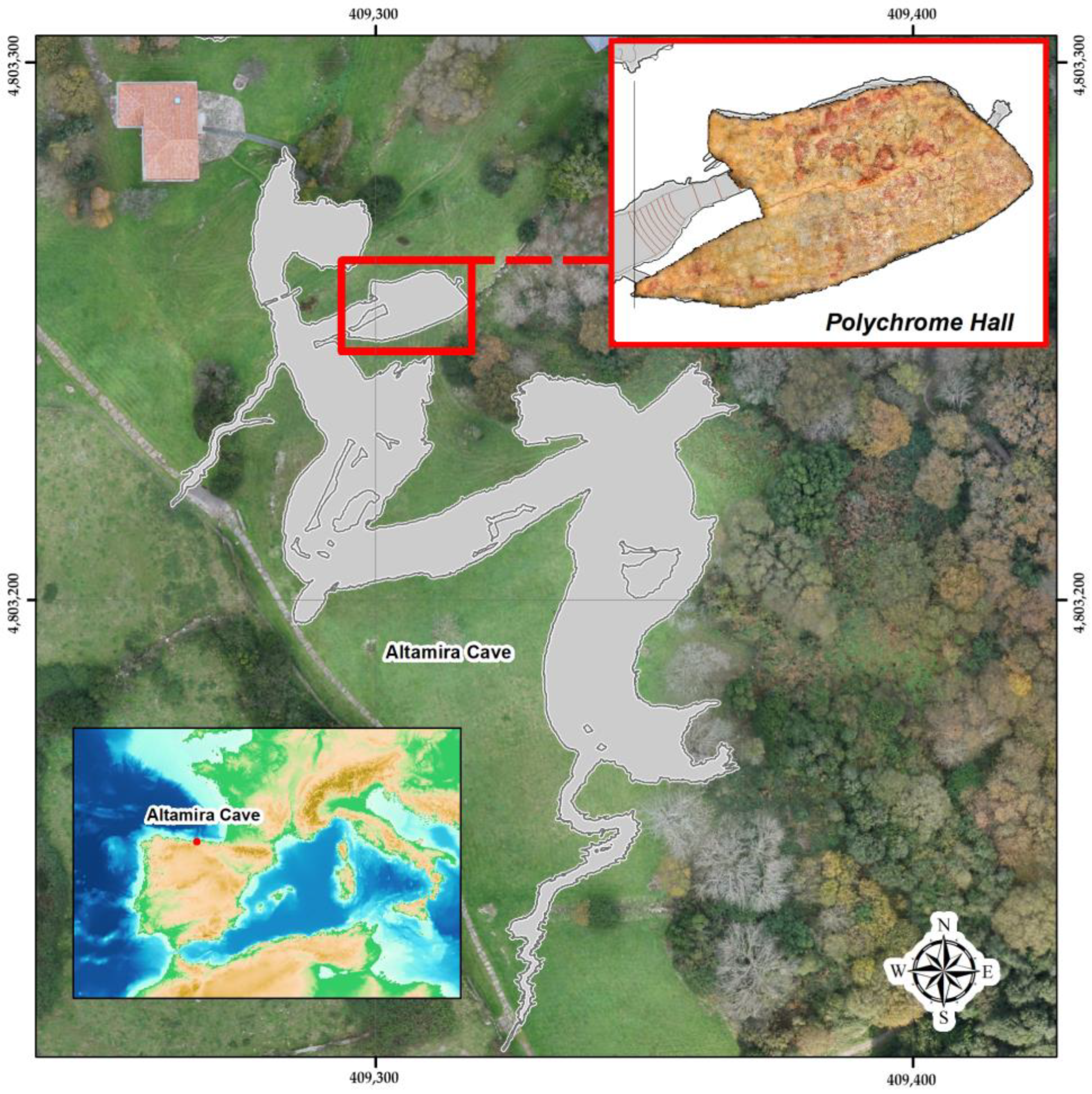
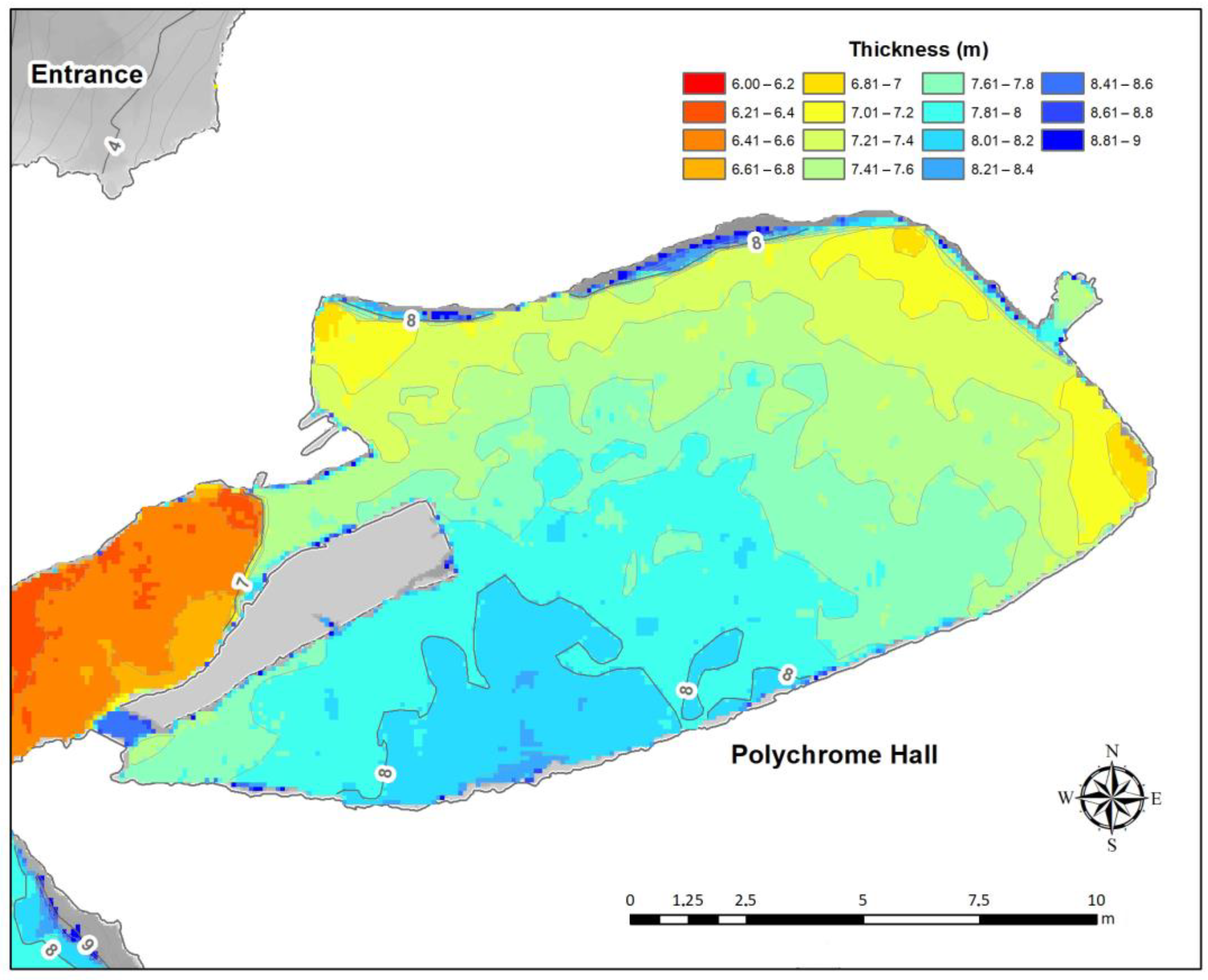
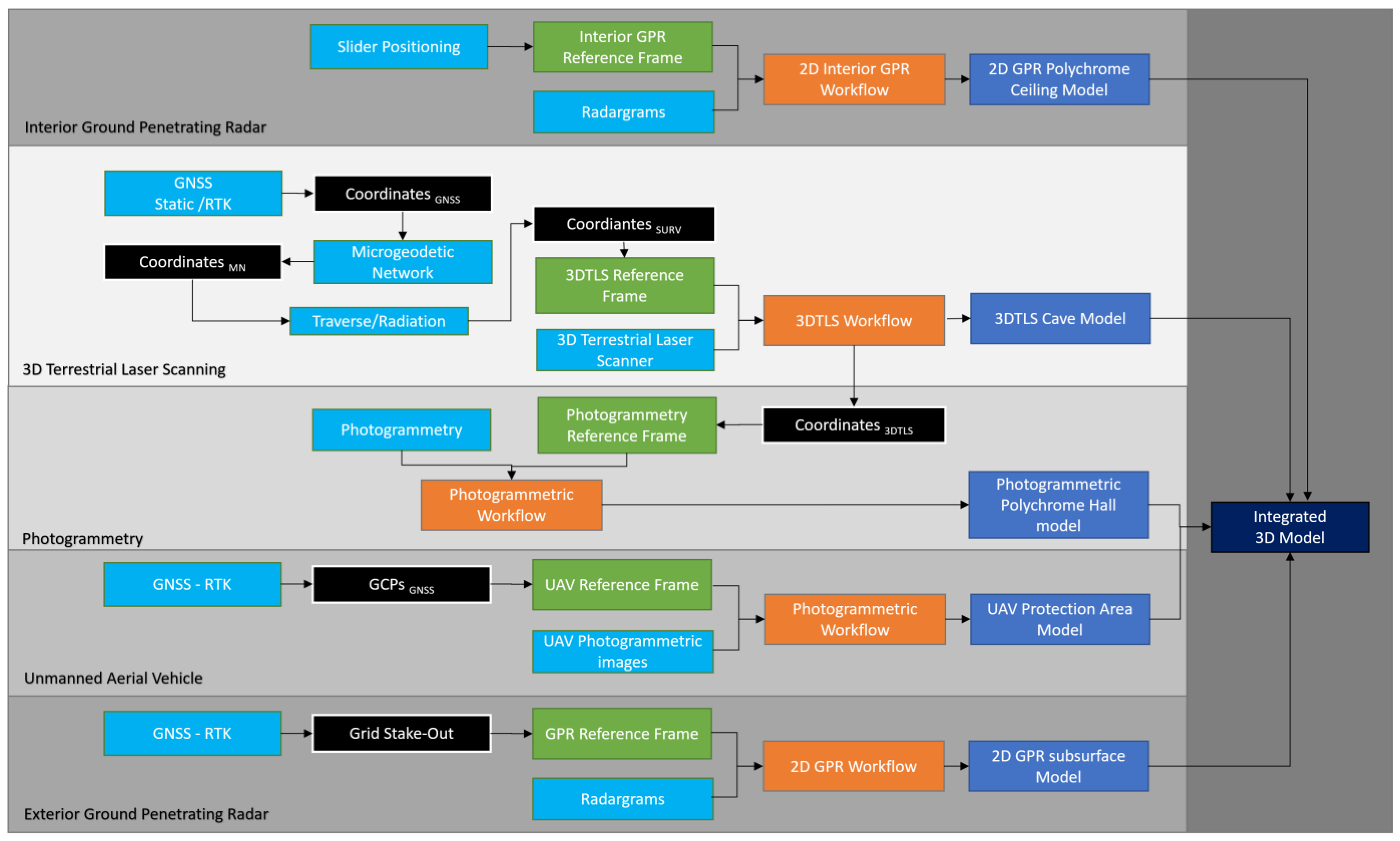
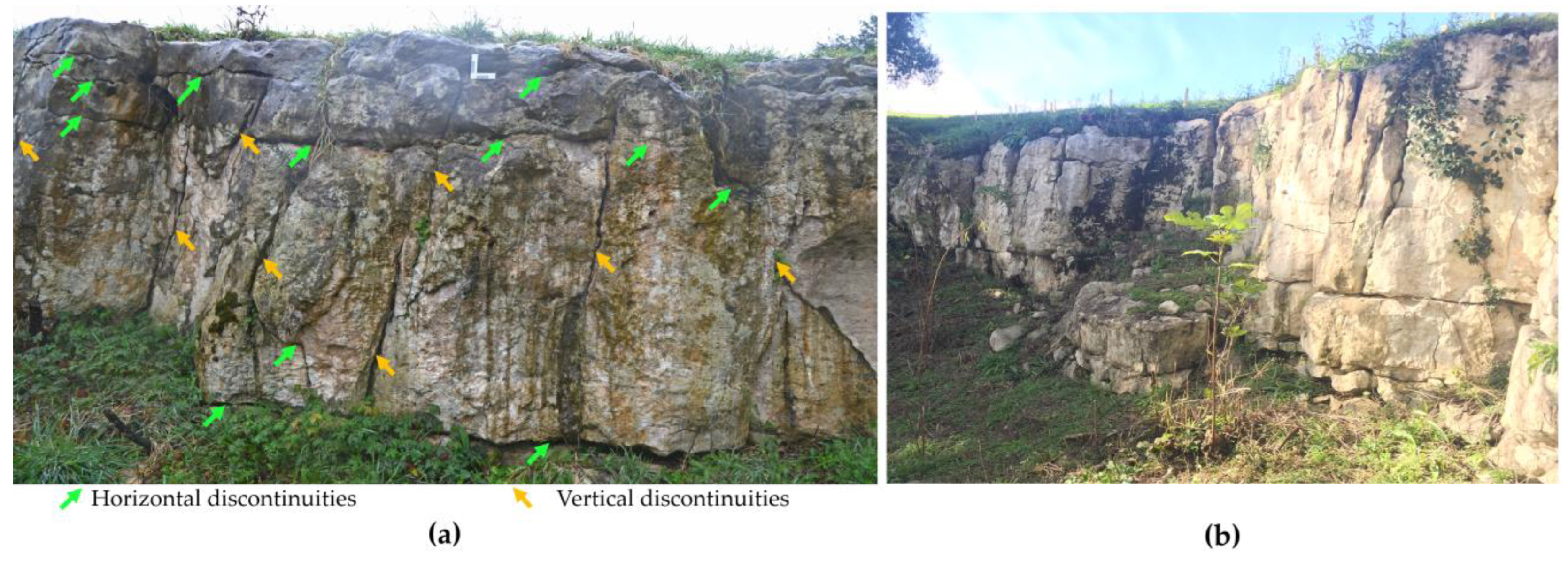
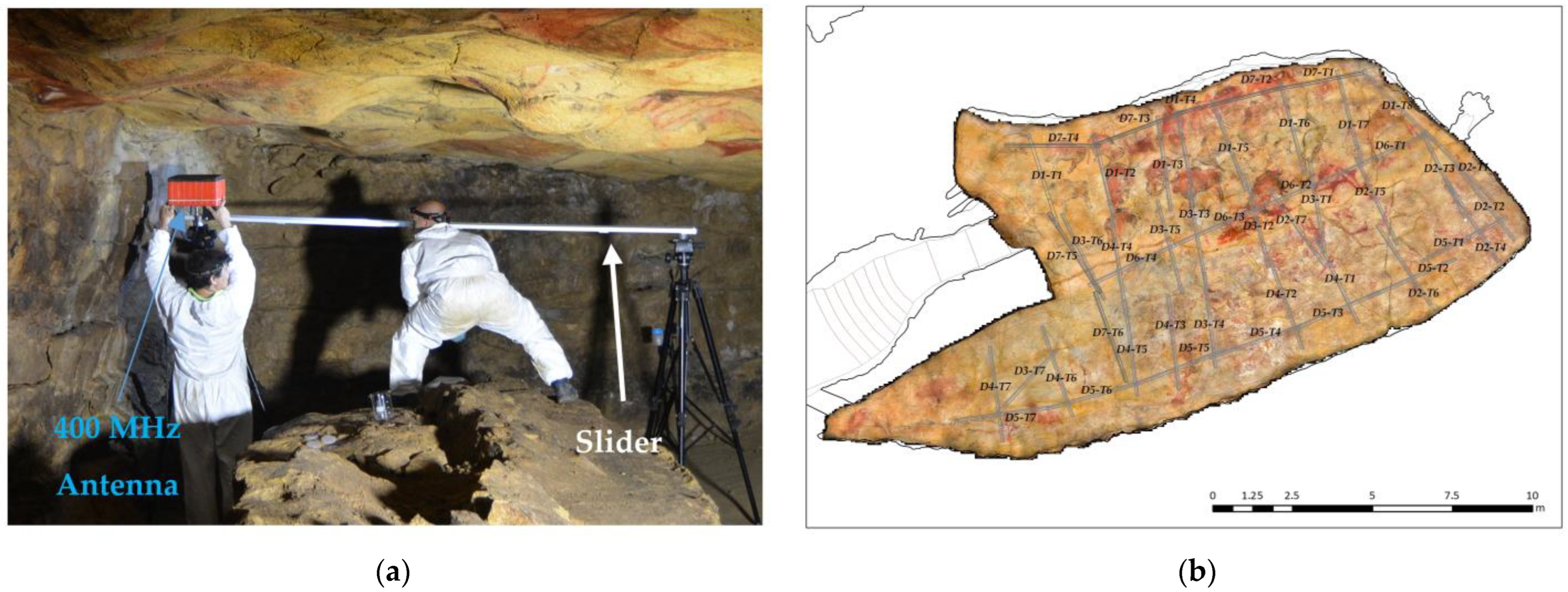

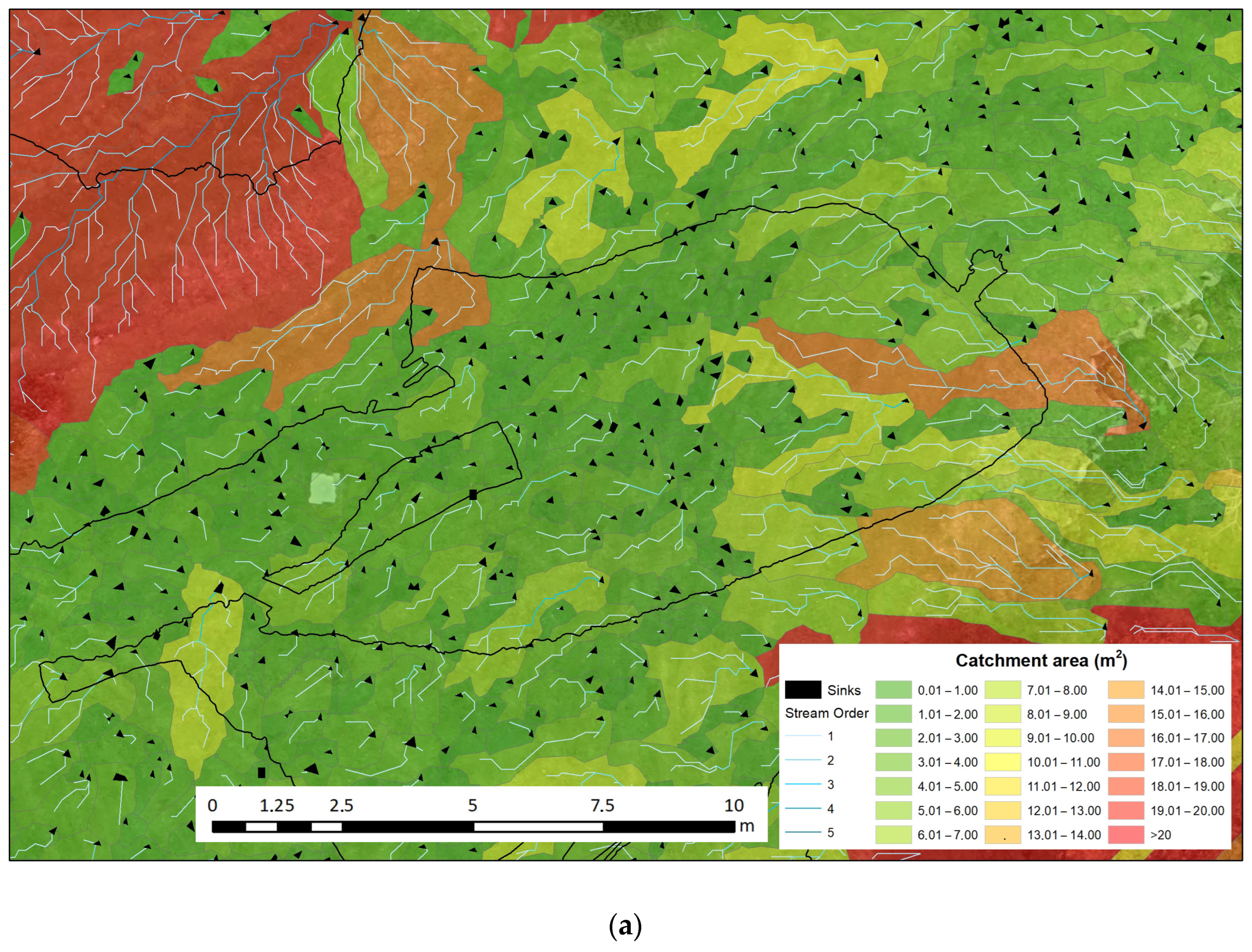

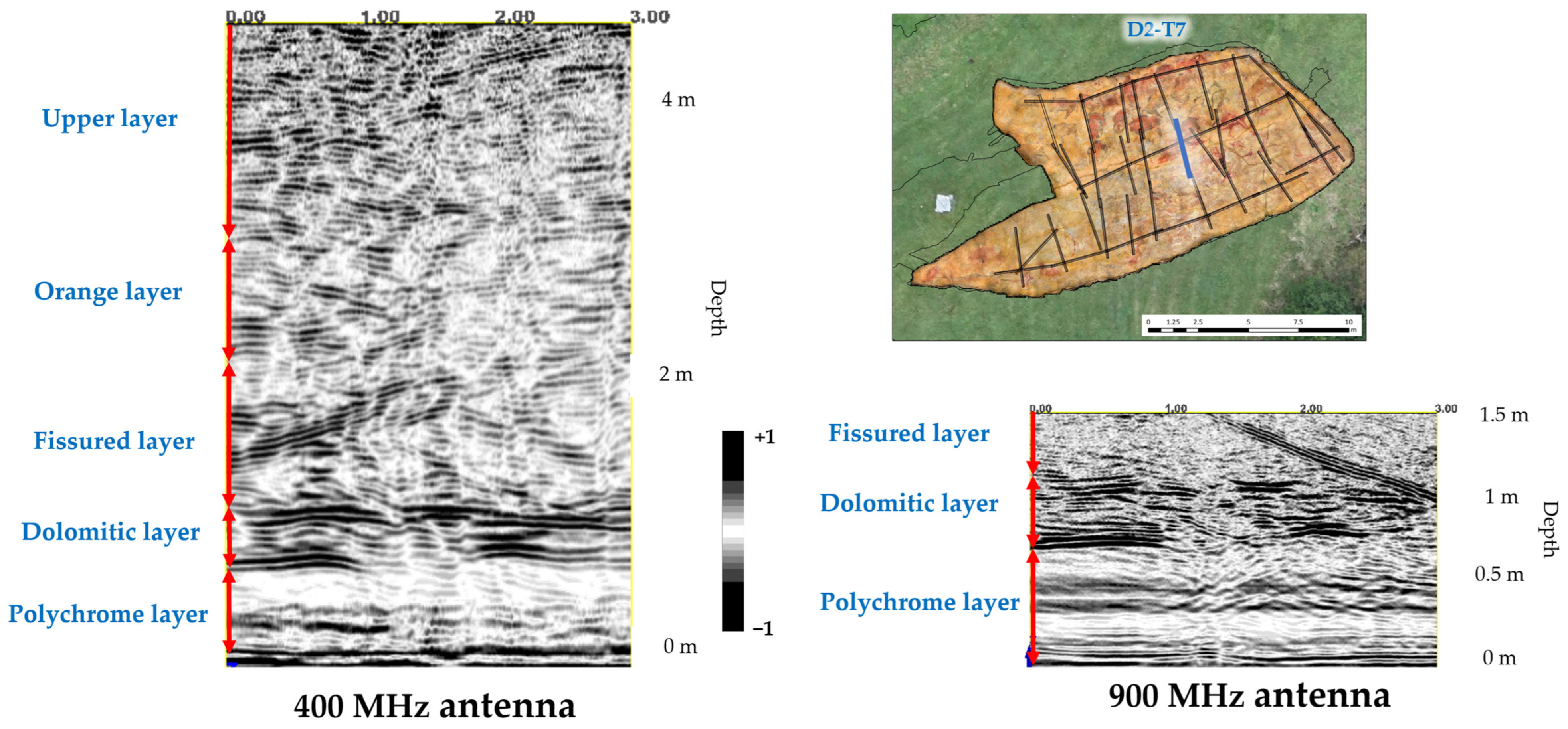
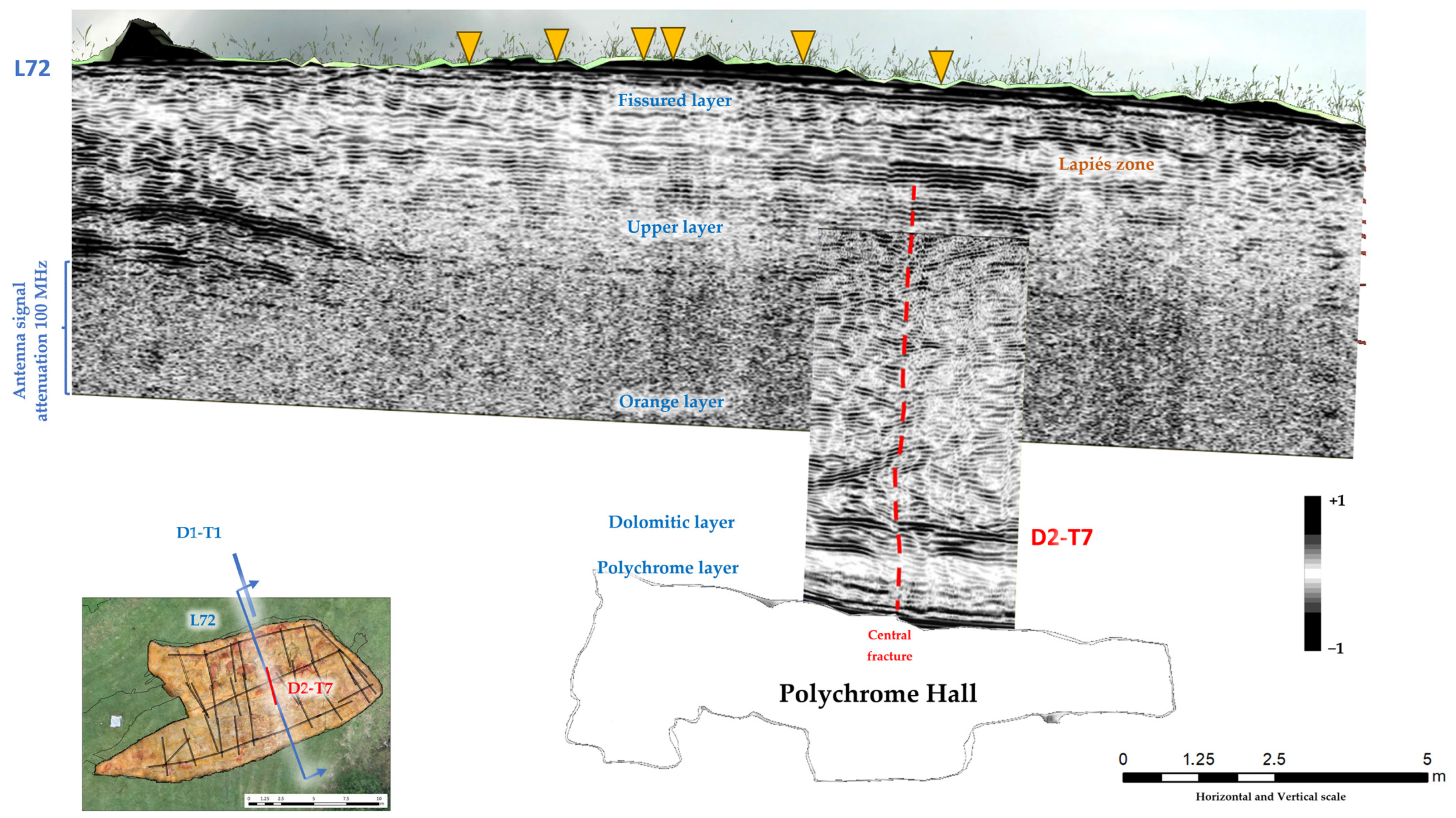
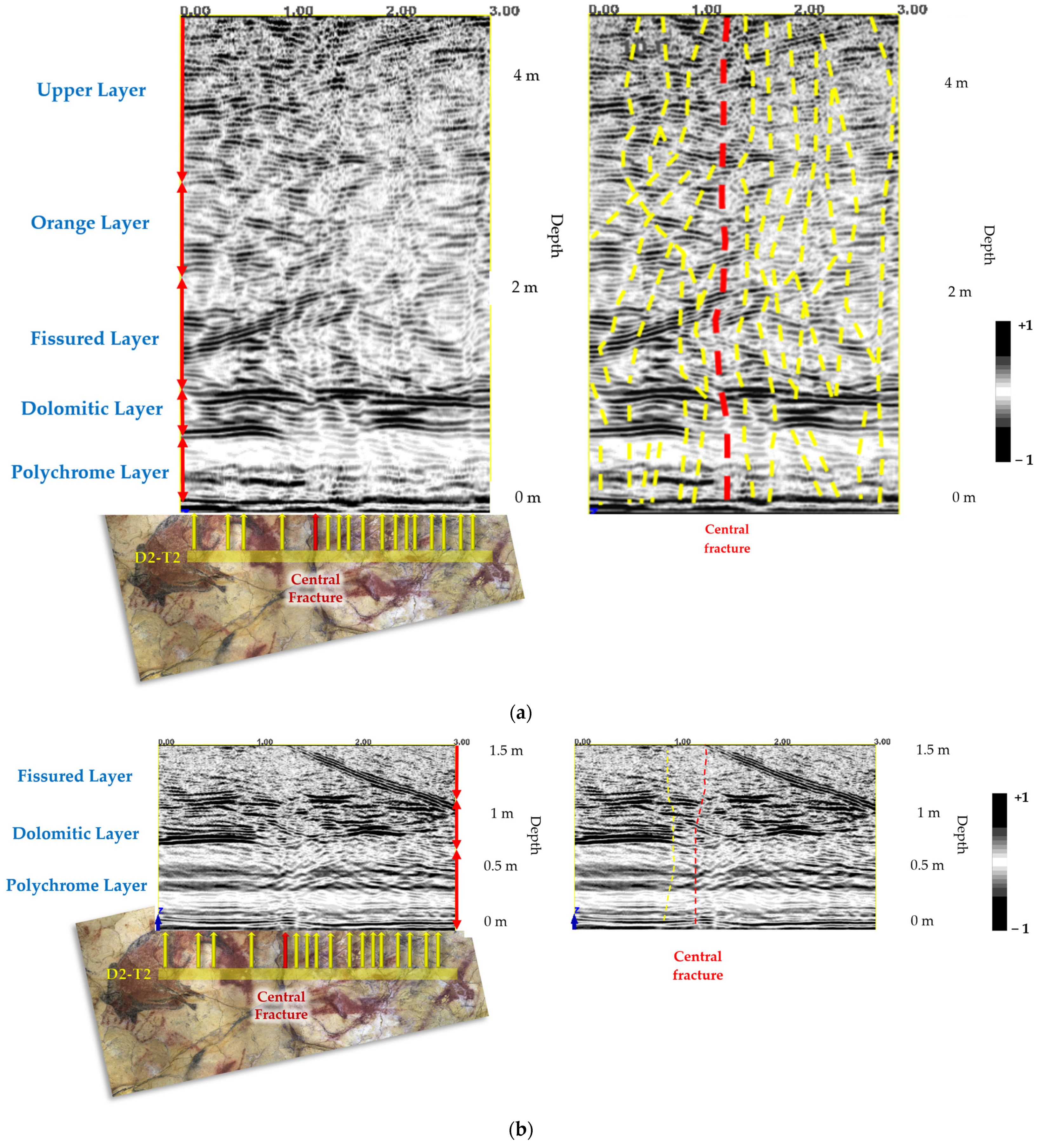

| Parameter | 400 MHz Antenna | 900 MHz Antenna |
|---|---|---|
| Central Frequency | 400 MHz | 900 MHz |
| Frequency Range | 250–600 MHz | 600–1200 MHz |
| Wavelength in air | 0.75 m | 0.33 m |
| Wavelength (ε = 7.5) | 0.306 m | 0.136 m |
| Minimum resolution (ε = 7.5) | 0.099 m | 0.044 m |
| Estimated maximum depth (ε = 7.5) N = 20. | 1.026 m | 0.456 m |
| Estimated maximum depth (ε = 7.5) N = 100. | 5.13 m | 2.28 m |
| Ground Conditions | Less affected by challenging conditions. | Moderate attenuation under these conditions. |
| Advantages | Deep penetration, versatile. | Balanced depth and resolution. |
| Disadvantages | Lower resolution, less suitable for shallow applications. | Reduced depth compared with 400 MHz. |
Disclaimer/Publisher’s Note: The statements, opinions and data contained in all publications are solely those of the individual author(s) and contributor(s) and not of MDPI and/or the editor(s). MDPI and/or the editor(s) disclaim responsibility for any injury to people or property resulting from any ideas, methods, instructions or products referred to in the content. |
© 2023 by the authors. Licensee MDPI, Basel, Switzerland. This article is an open access article distributed under the terms and conditions of the Creative Commons Attribution (CC BY) license (https://creativecommons.org/licenses/by/4.0/).
Share and Cite
Bayarri, V.; Prada, A.; García, F. A Multimodal Research Approach to Assessing the Karst Structural Conditions of the Ceiling of a Cave with Palaeolithic Cave Art Paintings: Polychrome Hall at Altamira Cave (Spain). Sensors 2023, 23, 9153. https://doi.org/10.3390/s23229153
Bayarri V, Prada A, García F. A Multimodal Research Approach to Assessing the Karst Structural Conditions of the Ceiling of a Cave with Palaeolithic Cave Art Paintings: Polychrome Hall at Altamira Cave (Spain). Sensors. 2023; 23(22):9153. https://doi.org/10.3390/s23229153
Chicago/Turabian StyleBayarri, Vicente, Alfredo Prada, and Francisco García. 2023. "A Multimodal Research Approach to Assessing the Karst Structural Conditions of the Ceiling of a Cave with Palaeolithic Cave Art Paintings: Polychrome Hall at Altamira Cave (Spain)" Sensors 23, no. 22: 9153. https://doi.org/10.3390/s23229153
APA StyleBayarri, V., Prada, A., & García, F. (2023). A Multimodal Research Approach to Assessing the Karst Structural Conditions of the Ceiling of a Cave with Palaeolithic Cave Art Paintings: Polychrome Hall at Altamira Cave (Spain). Sensors, 23(22), 9153. https://doi.org/10.3390/s23229153






